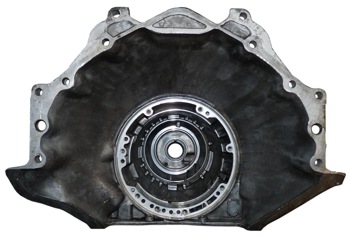Nearly all of the GM automatic transmissions have a few things in common. They are all made of aluminum. The Turbo 350 is arguably GM’s most popular automatic transmission with the aftermarket even today. This is espescially true for the people who are still using the generation I and II small-block Chevy.
This Monster Powertrain Package is complete with all the features you need for a reliable Chevy 383 & Automatic Overdrive TH350 Transmission from a researched and developed combination of components. You'll have all of the reliability that you would want from a good street cruising motor while still being able to have that power you need. BTE’s TH350 transmissions are well suited for street and race track performance. The TH350’s low rotating mass, gear ratios, and overall lightweight construction make it a great for light to moderate weight cars with power ranging from 350 to 800 horsepower. Buy high quality Turbo 350 Hard Parts, Soft Parts and Rebuild Kits from Global Transmission Parts and get fast flat rate $5.00 shipping on every order. Toggle menu (844) 298-6404. All TH350 transmissions include a new pan. Stage 1 TH350 – 500+ HP/TQ Stage 1 TH350 is reliable to over 500 HP/TQ. It’s a very tough unit.
Chevy Th350 Transmission Diagram
Although the TH350 has been phased out for more than 20 years, you can still find one in the salvage yard. You certainly should not depend on the tech working at the yard for confirmation of what you have. You’ll certainly find them at swap meets and craigslist. Do not depend on someone’s word when they tell you that they have something. I am not saying that people are liars. Most of the time they are not. It’s often the case that the part you are looking at has been sitting around someone’s garage for a long time and they don’t perfectly recall what they have.

There are a few things that all of the longitudinal gm automatic transmissions have in common. They all have basically the same bolt pattern on the bellhousing. Although if you use an older transmission with a newer “LS” engine, you’ll have an extra bolt. But, they do not all bolt into the crossmember in the same space. They are also not the same length. Therefore, they are not all naturally compatible with one another.
[the_ad id=”1070″]
Identifying the TH350 the Easy Way
Certainly the easiest way to identify a GM automatic transmission is by the bolt pattern. The TH350 has a 13 bolt pan gasket. This is a fine way to whittle what you have in front of you. If you counted 13, you are either looking at the Turbo 350 Transmission or the Turbo 400.
You’ll also notice that the pan on the turbo 400 has quite a few more angles than the turbo 350. So, if your pan doesn’t look like a square with a corner taken out than you may want to move along.
Although they aren’t very common, there is a transmission based on the TH35o known as the TH250. It’s visually similar to it’s bigger sibling, but lacks the capability to handle a lot of torque. GM often bolted it behind it’s more anemic six cylinder engines.
It’s gosh darn tough to identify one visually. You’ll need to look above the coolant line fittings to see if there is a threaded screw there. It’s for band adjustment. Most of the info on this site I just know. In this particular case I found that right here:
Using the ID Tag for Identification
Really it is a lot easier to ID a transmission visually compared to the alternative of decoding it, but it is reasonable to try and understand exactly what you have. Now, for the the purpose of this guide there are two different ways that GM printed the the serial label. They changed the way that they labeled their transmissions for the 1967 model year. The TH350 began production in the 1969 model year. That would put it squarely in the second era, and this is how it went.
You’ll need to find the ID tag before you get anywhere. This can be extremely difficult on the TH35o particularly because the ID tag can be found on several different places on the transmission. It can be found on:
- Near where the shift linkage attaches to the body
- Just above the housing on the right side of the pan
- On the passenger side on a flange by the bellhousing
So, you if you are trying to wiggle under a car to read this thing it can be very problematic. You’ll not only need to hunt for this thing, but it needs to be free of enough grime to be legible.
You’ll be looking for these numbers on the ID tag in order to properly tell exactly what kind of transmission that you are dealing with. Most gm transmissions use the M RPO code. Here is a pretty complete list of all of them from the folks over at NastyZ28. The more common ones are:
- MV4- This code identifies your turbo 350 as a “C” model, which had a locking torque converter. This code was used for ten years from 1976 to 1986.
- MX2- Another 350C code. Found on 76-84 models
- MX3- Another Turbo 350C code. 1976-1981 model years.
- MX5- Turbo 350C, 1982 and 1983 only.
- M33- This standard Turbo 350 code identifies it as a standard THM350. This version did not have a locking converter. This one was manufactured from 76-81.
- M38- Standard Turbo 350 manufactured from 1976 to 1981.
Article may contain affiliate links. As an Amazon Associate I earn from qualifying purchases.
The Turbo 350 transmission was introduced beginning in 1969.
This transmission was a 3 speed automatic transmission developed jointly by Chevrolet and Buick. Although they were both under the General Motors umbrella, at the time they acted as completely separate entities, whereas now the developers at General Motors powertrain work only for GM, not Chevrolet or Buick.

This transmission replaced the GM Powerglide automatic transmission, which was a 2 speed automatic transmission that was in production for 23 years.
The Turbo 350, known by the name TH350, was used in nearly all GM rear wheel drive car and truck applications during its tenure. To name a few, this transmission was used in the Caprice, Chevelle, Corvette, Blazer, and Nova.
The TH350 was introduced in 1969 as a replacement to the Powerglide 2 speed automatic transmission. While the phase-in began in 1969, it was not complete until the 1973 when the Powerglide fully phased out.
This transmission was in production for about 15 years, being fully replaced by the 700R4 in 1984. In addition, a TH350-C added the lockup torque converter capability and was introduced in 1979.
Common Problems
While the TH350 is no longer in production, the transmission is still used for many classic car builds. The TH350 was popular for a variety of reasons. The simple fact that this transmission had an extra gear compared to its predecessor is an advantage from the start.
This transmission is also known for being strong and versatile, in addition to being quite compact.
One of the weaknesses noted about this transmission was wobble of the direct clutch drum.

Turbo 350 Performance Specs
Rebuilt Th350 Transmission
The maximum torque that this transmission could handle varied depending on the application to which it was being applied. The transmission would be modified so that the transmissions behind the stronger engines were able to handle the additional torque.
The most torque from an engine that this transmission was applied to was 410 lb-ft. This is an automatic transmission that is longitudinally mounted, making it applicable for rear-wheel drive cars.
This transmission is a 3 speed, and no overdrive gear was available. The gear ratios used for this transmission were 2.52 for 1st gear, 1.52 for 2nd gear, and 1.0 for 3rd gear.
Construction and Size
The Turbo 350 transmission was a single piece transmission with the bell housing integrated into the transmission body. The transmission casing is made of cast aluminum.
The TH350 was also known for its quite short length, with an overall length of 21.75”. That also converts into a lighter transmission that carries a weight of 120 pounds.
The TH350 takes about 4 quarts in the pan, and then requires additional based on the torque converter being used. When combined with a 9.5” converter, the overall requirement is around 10 quarts.
The Turbo 350 transmission, commonly known as the TH350, was a 3 speed automatic transmission that began phasing out the GM Powerglide in 1969. The TH350 then lasted 15 years before eventually being replaced by the 700R4.
The TH350 offered a substantial improvement to its predecessor, with the additional gear being an obvious improvement from the beginning. During its time of usage, the TH350 was used in virtually all rear wheel drive vehicles from General Motors, including the Corvette, Chevelle, and Nova. This transmission was very popular due to its strength and versatility, as is still used in many vintage cars to this day.
